Lancia Thema 2012 Owner handbook (in English)
Manufacturer: LANCIA, Model Year: 2012, Model line: Thema, Model: Lancia Thema 2012Pages: 316, PDF Size: 3.85 MB
Page 261 of 316
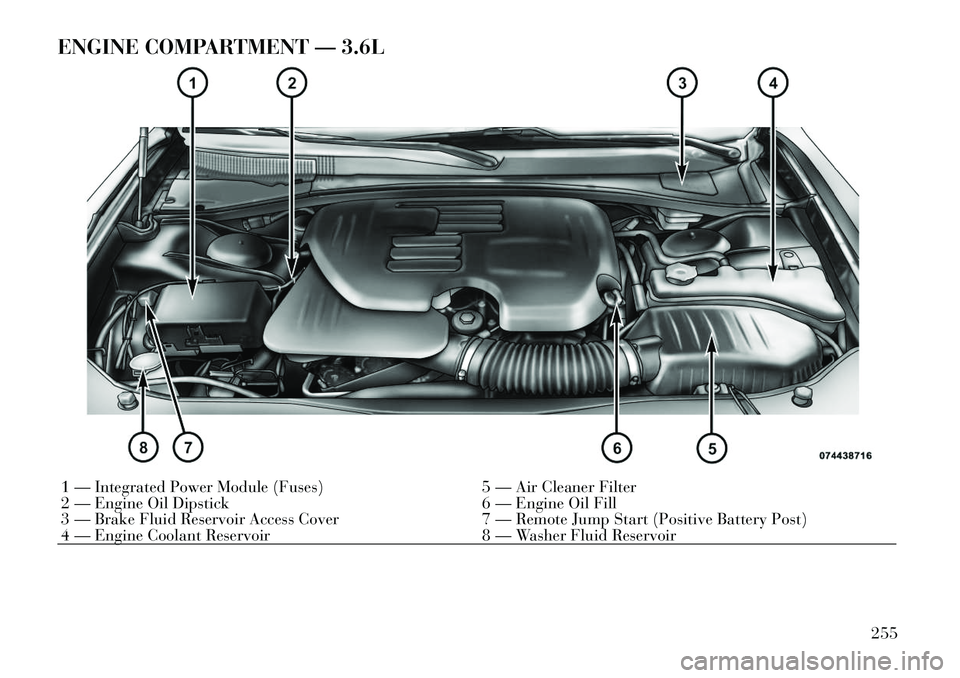
ENGINE COMPARTMENT — 3.6L1 — Integrated Power Module (Fuses)5 — Air Cleaner Filter
2 — Engine Oil Dipstick 6 — Engine Oil Fill
3 — Brake Fluid Reservoir Access Cover 7 — Remote Jump Start (Positive Battery Post)
4 — Engine Coolant Reservoir 8 — Washer Fluid Reservoir
255
Page 262 of 316
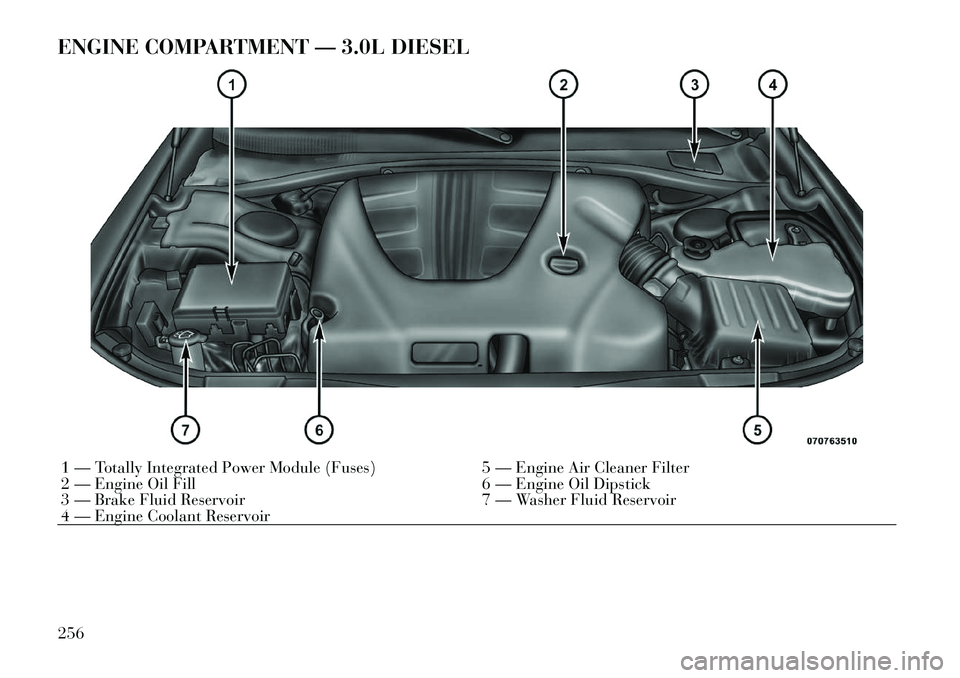
ENGINE COMPARTMENT — 3.0L DIESEL1 — Totally Integrated Power Module (Fuses)5 — Engine Air Cleaner Filter
2 — Engine Oil Fill 6 — Engine Oil Dipstick
3 — Brake Fluid Reservoir 7 — Washer Fluid Reservoir
4 — Engine Coolant Reservoir
256
Page 263 of 316

ONBOARD DIAGNOSTIC
SYSTEM — OBD II
Your vehicle is equipped with a so-
phisticated onboard diagnostic sys-
tem called OBD II. This system moni-
tors the performance of the emissions,
engine, and automatic transmission
control systems. When these systems
are operating properly, your vehicle
will provide excellent performance
and fuel economy, as well as engine
emissions well within current govern-
ment regulations.
If any of these systems require service,
the OBD II system will turn on the
“Malfunction Indicator Light (MIL).”
It will also store diagnostic codes and
other information to assist your ser-
vice technician in making repairs. Al-
though your vehicle will usually be
drivable and not need towing, see
your authorized dealer for service as
soon as possible.
CAUTION!
Prolonged driving with the MILon could cause further damage to
the emissions control system. It
could also affect fuel economy
and driveability. The vehicle must
be serviced before any emissions
tests can be performed.
If the MIL is flashing while the
engine is running, severe catalytic
converter damage and power loss
will soon occur. Immediate service
is required.
REPLACEMENT PARTS
Use of genuine parts for normal/
scheduled maintenance and repairs is
highly recommended to ensure the de-
signed performance.
Damage or failures caused by the use
of parts which are not quality-
equivalent to genuine parts for main-
tenance and repairs will not be cov-
ered by the manufacturer’s warranty. MAINTENANCE
PROCEDURES
The pages that follow contain the
re-
quired maintenance services deter-
mined by the engineers who designed
your vehicle.
Besides those maintenance items
specified in the fixed maintenance
schedule, there are other components
which may require servicing or re-
placement in the future.
CAUTION!
Failure to properly maintain your vehicle or perform repairs and
service when necessary could re-
sult in more costly repairs, dam-
age to other components or nega-
tively impact vehicle
performance. Immediately have
potential malfunctions examined
by an authorized dealership or
qualified repair center.
(Continued)
257
Page 264 of 316

CAUTION!(Continued)
Car maintenance should be done
at a LANCIA Dealership. For rou-
tine and minor maintenance op-
erations you wish to carry out
yourself, we do recommend you
have the proper equipment, genu-
ine LANCIA spare parts and the
necessary fluids; do not however
carry out these operations if you
have no experience.
Your vehicle has been built with
improved fluids that protect the
performance and durability of
your vehicle and also allow ex-
tended maintenance intervals. Do
not use chemical flushes in these
components as the chemicals can
damage your engine, transmis-
sion, power steering or air condi-
tioning. Such damage is not cov-
ered by the New Vehicle Limited
Warranty. If a flush is needed be-
cause of component malfunction,
use only the specified fluid for the
flushing procedure. ENGINE OIL – GASOLINE
ENGINE
Checking Oil Level
To assure proper lubrication of your
vehicle's engine, the engine oil must
be maintained at the correct level.
The best time to check the engine oil
level is about five minutes after a fully
warmed up engine is shut off or before
starting the engine after it has sat
overnight.
Checking the oil while the vehicle is
on level ground will improve the
ac-
curacy of the oil level readings. Main-
tain the oil level in the SAFE level
range. Adding 0.95 Liter of oil when
the level is at the bottom of the SAFE
range will result in the level being at
the top of the SAFE range.
CAUTION!
Overfilling or underfilling the
crankcase will cause aeration or loss
of oil pressure. This could damage
your engine.
CAUTION!
Car maintenance should be done at
a LANCIA Dealership. For routine
and minor maintenance operations
you wish to carry out yourself, we do
recommend you have the proper
equipment, genuine LANCIA spare
parts and the necessary fluids; do
not however carry out these opera-
tions if you have no experience.
Change Engine Oil
Refer to the “Maintenance Schedule”
for the proper maintenance intervals.
Engine Oil Selection – 3.6L
Engine
SAE Grade 5W-30 SELENIA K
POWER fully synthetic engine oil that
meets FIAT Qualification 9.55535
API SN, ILSAC GF-5 or equivalent.
The engine oil filler cap also shows the
recommended engine oil viscosity for
your vehicle. For information on en-
gine oil filler cap location, refer to
“Engine Compartment” in “Main-
taining Your Vehicle” for further in-
formation.
258
Page 265 of 316
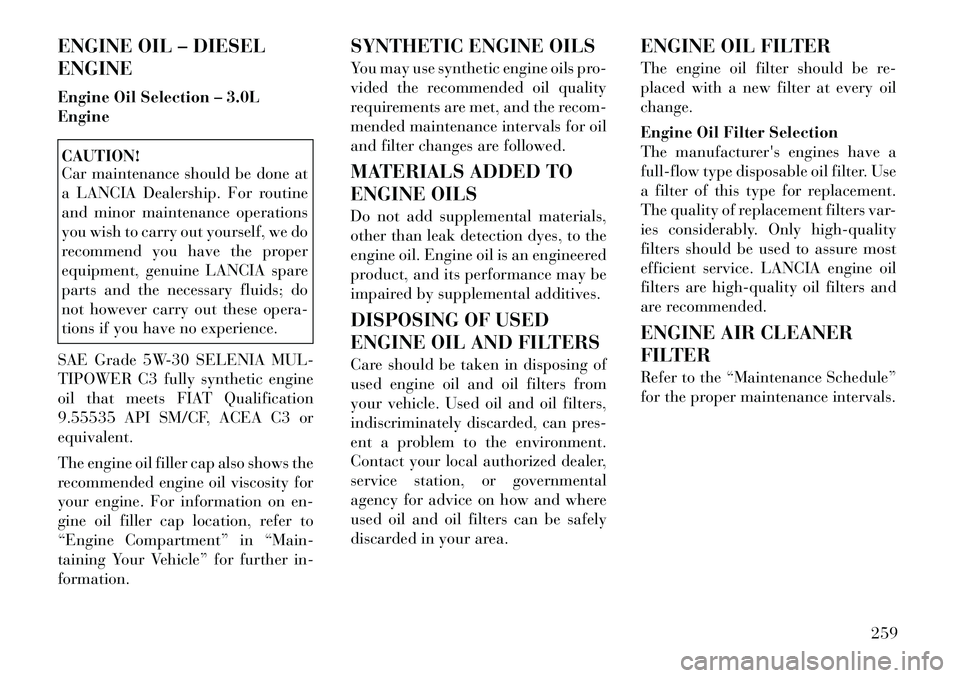
ENGINE OIL – DIESEL
ENGINE
Engine Oil Selection – 3.0L
EngineCAUTION!
Car maintenance should be done at
a LANCIA Dealership. For routine
and minor maintenance operations
you wish to carry out yourself, we do
recommend you have the proper
equipment, genuine LANCIA spare
parts and the necessary fluids; do
not however carry out these opera-
tions if you have no experience.
SAE Grade 5W-30 SELENIA MUL-
TIPOWER C3 fully synthetic engine
oil that meets FIAT Qualification
9.55535 API SM/CF, ACEA C3 or
equivalent.
The engine oil filler cap also shows the
recommended engine oil viscosity for
your engine. For information on en-
gine oil filler cap location, refer to
“Engine Compartment” in “Main-
taining Your Vehicle” for further in-
formation. SYNTHETIC ENGINE OILS
You may use synthetic engine oils pro-
vided the recommended oil quality
requirements are met, and the recom-
mended maintenance intervals for oil
and filter changes are followed.
MATERIALS ADDED TO
ENGINE OILS
Do not add supplemental materials,
other than leak detection dyes, to the
engine oil. Engine oil is an engineered
product, and its performance may be
impaired by supplemental additives.
DISPOSING OF USED
ENGINE OIL AND FILTERS
Care should be taken in disposing of
used engine oil and oil filters from
your vehicle. Used oil and oil filters,
indiscriminately discarded, can pres-
ent a problem to the environment.
Contact your local authorized dealer,
service station, or governmental
agency for advice on how and where
used oil and oil filters can be safely
discarded in your area.
ENGINE OIL FILTER
The engine oil filter should be re-
placed with a new filter at every oil
change.
Engine Oil Filter Selection
The manufactur
er's engines have a
full-flow type disposable oil filter. Use
a filter of this type for replacement.
The quality of replacement filters var-
ies considerably. Only high-quality
filters should be used to assure most
efficient service. LANCIA engine oil
filters are high-quality oil filters and
are recommended.
ENGINE AIR CLEANER
FILTER
Refer to the “Maintenance Schedule”
for the proper maintenance intervals.
259
Page 266 of 316
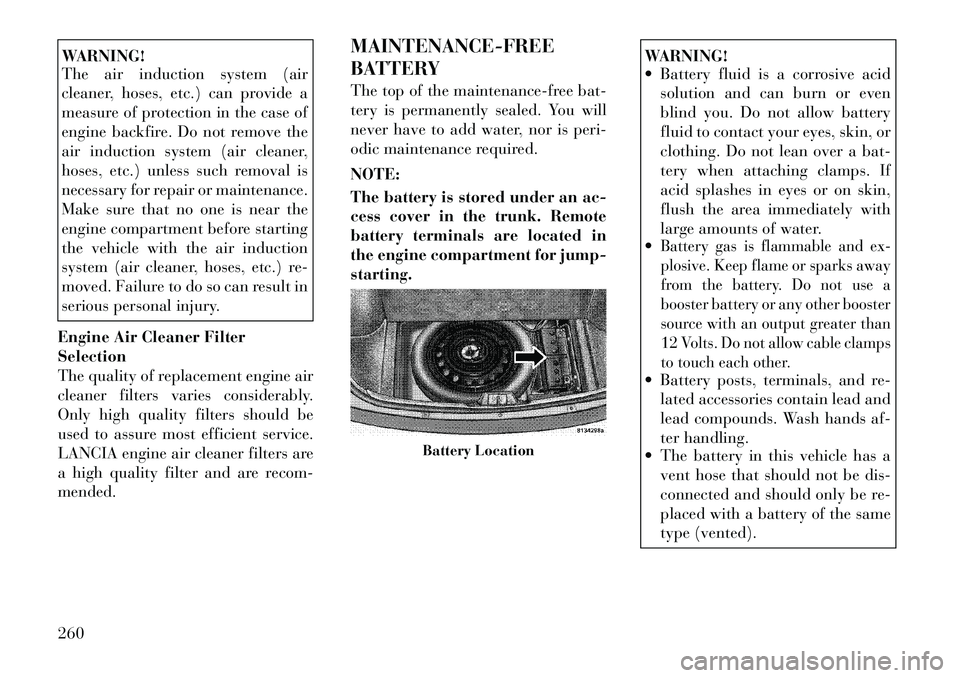
WARNING!
The air induction system (air
cleaner, hoses, etc.) can provide a
measure of protection in the case of
engine backfire. Do not remove the
air induction system (air cleaner,
hoses, etc.) unless such removal is
necessary for repair or maintenance.
Make sure that no one is near the
engine compartment before starting
the vehicle with the air induction
system (air cleaner, hoses, etc.) re-
moved. Failure to do so can result in
serious personal injury.
Engine Air Cleaner Filter
Selection
The quality of replacement engine air
cleaner filters varies considerably.
Only high quality filters should be
used to assure most efficient service.
LANCIA engine air cleaner filters are
a high quality filter and are recom-
mended. MAINTENANCE-FREE
BATTERY
The top of the maintenance-free bat-
tery is permanently sealed. You will
never have to add water, nor is peri-
odic maintenance required.
NOTE:
The battery is stored under an ac-
cess cover in the trunk. Remote
battery terminals are located in
the engine compartment for jump-
starting.
WARNING!
Battery fluid is a corrosive acid
solution and can burn or even
blind you. Do not allow battery
fluid to contact your eyes, skin, or
clothing. Do not lean over a bat-
tery when attaching clamps. If
acid splashes in eyes or on skin,
flush the area immediately with
large amounts of water.
Battery gas is flammable and ex-
plosive. Keep flame or sparks away
from the battery. Do not use a
booster battery or any other booster
source with an output greater than
12 Volts. Do not allow cable clamps
to touch each other. Battery posts, terminals, and re-
lated accessories contain lead and
lead compounds. Wash hands af-
ter handling.
The battery in this vehicle has a
vent hose that should not be dis-
connected and should only be re-
placed with a battery of the same
type (vented).
Battery Location
260
Page 267 of 316
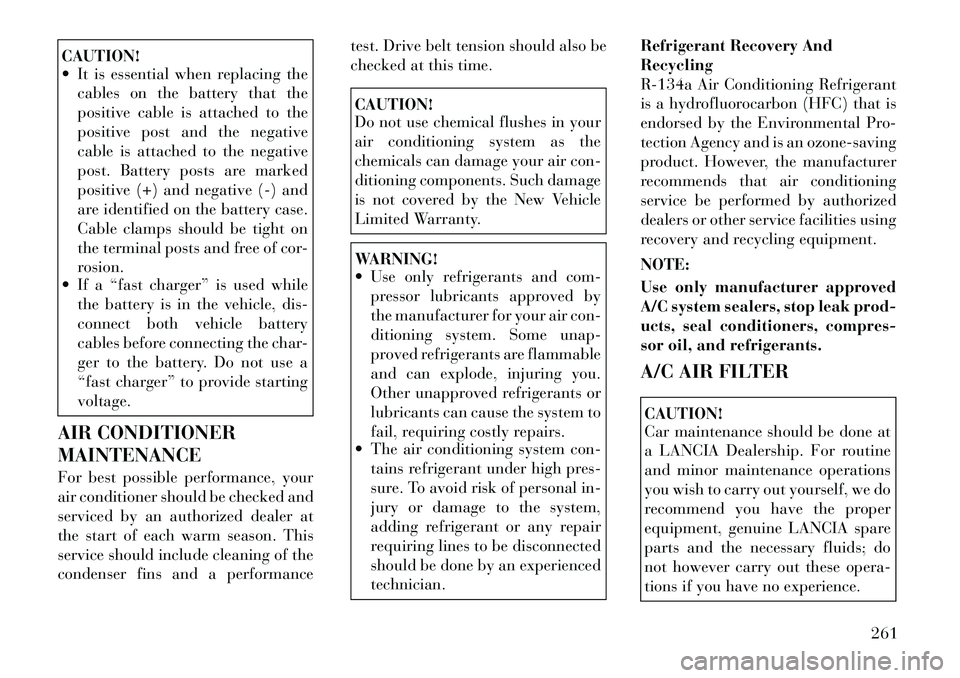
CAUTION!
It is essential when replacing thecables on the battery that the
positive cable is attached to the
positive post and the negative
cable is attached to the negative
post. Battery posts are marked
positive (+) and negative (-) and
are identified on the battery case.
Cable clamps should be tight on
the terminal posts and free of cor-
rosion.
If a “fast charger” is used while
the battery is in the vehicle, dis-
connect both vehicle battery
cables before connecting the char-
ger to the battery. Do not use a
“fast charger” to provide starting
voltage.
AIR CONDITIONER
MAINTENANCE
For best possible performance, your
air conditioner should be checked and
serviced by an authorized dealer at
the start of each warm season. This
service should include cleaning of the
condenser fins and a performance test. Drive belt tension should also be
checked at this time.
CAUTION!
Do not use chemical flushes in your
air conditioning system as the
chemicals can damage your air con-
ditioning components. Such damage
is not covered by the New Vehicle
Limited Warranty.WARNING!
Use only refrigerants and com-
pressor lubricants approved by
the manufacturer for your air con-
ditioning system. Some unap-
proved refrigerants are flammable
and can explode, injuring you.
Other unapproved refrigerants or
lubricants can cause the system to
fail, requiring costly repairs.
The air conditioning system con-
tains refrigerant under high pres-
sure. To avoid risk of personal in-
jury or damage to the system,
adding refrigerant or any repair
requiring lines to be disconnected
should be done by an experienced
technician. Refrigerant Recovery And
Recycling
R-134a Air Conditioning Refrigerant
is a hydrofluorocarbon (HFC) that is
endorsed by the Environmental Pro-
tection Agency and is an ozone-saving
product. However, the manufacturer
recommends that air conditioning
service be performed by authorized
dealers or other service facilities using
recovery and recycling equipment.
NOTE:
Use only manufacturer approved
A/C system sealers, stop leak prod-
ucts, seal conditioners, compres-
sor oil, and refrigerants.
A/C AIR FILTER
CAUTION!
Car maintenance should be done at
a LANCIA Dealership. For routine
and minor maintenance operations
you wish to carry out yourself, we do
recommend you have the proper
equipment, genuine LANCIA spare
parts and the necessary fluids; do
not however carry out these opera-
tions if you have no experience.
261
Page 268 of 316
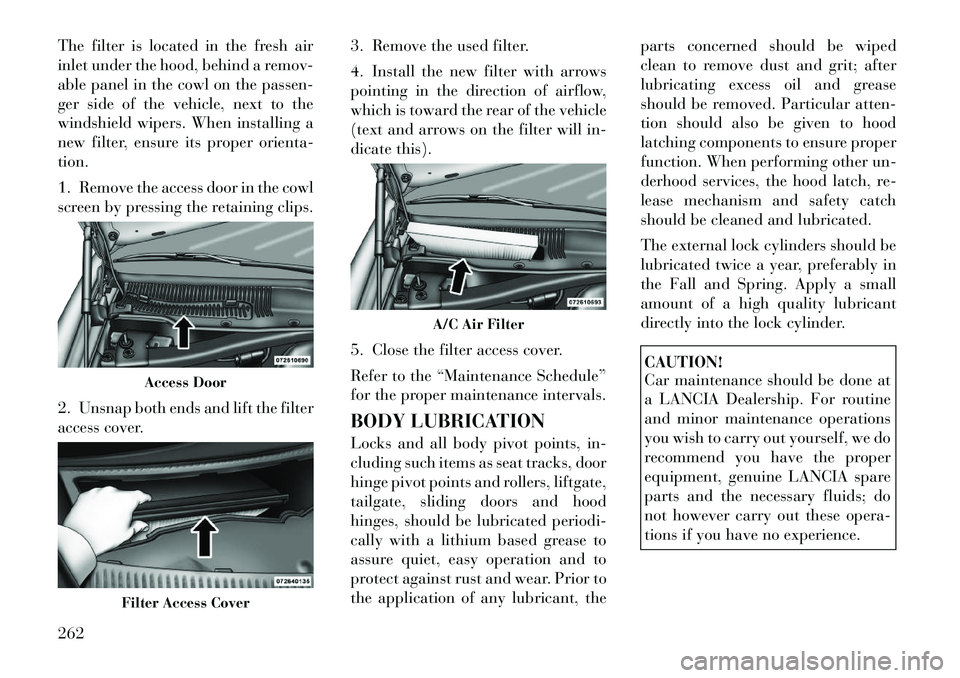
The filter is located in the fresh air
inlet under the hood, behind a remov-
able panel in the cowl on the passen-
ger side of the vehicle, next to the
windshield wipers. When installing a
new filter, ensure its proper orienta-
tion.
1. Remove the access door in the cowl
screen by pressing the retaining clips.
2. Unsnap both ends and lift the filter
access cover.3. Remove the used filter.
4. Install the new filter with arrows
pointing in the direction of airflow,
which is toward the rear of the vehicle
(text and arrows on the filter will in-
dicate this).
5. Close the filter access cover.
Refer to the “Maintenance Schedule”
for the proper maintenance intervals.
BODY LUBRICATION
Locks and all body pivot points, in-
cluding such items as seat tracks, door
hinge pivot points and rollers, liftgate,
tailgate, sliding doors and hood
hinges, should be lubricated periodi-
cally with a lithium based grease to
assure quiet, easy operation and to
protect against rust and wear. Prior to
the application of any lubricant, theparts concerned should be wiped
clean to remove dust and grit; after
lubricating excess oil and grease
should be removed. Particular atten-
tion should also be given to hood
latching components to ensure proper
function. When performing other un-
derhood services, the hood latch, re-
lease mechanism and safety catch
should be cleaned and lubricated.
The external lock cylinders should be
lubricated twice a year, preferably in
the Fall and Spring. Apply a small
amount of a high quality lubricant
directly into the lock cylinder.
CAUTION!
Car maintenance should be done at
a LANCIA Dealership. For routine
and minor maintenance operations
you wish to carry out yourself, we do
recommend you have the proper
equipment, genuine LANCIA spare
parts and the necessary fluids; do
not however carry out these opera-
tions if you have no experience.
Access Door
Filter Access Cover
A/C Air Filter
262
Page 269 of 316

WINDSHIELD WIPER
BLADES
Clean the rubber edges of the wiper
blades and the windshield periodi-
cally with a sponge or soft cloth and a
mild nonabrasive cleaner. This will
remove accumulations of salt or road
film.
Operation of the wipers on dry glass
for long periods may cause deteriora-
tion of the wiper blades. Always use
washer fluid when using the wipers to
remove salt or dirt from a dry wind-
shield.
Avoid using the wiper blades to re-
move frost or ice from the windshield.
Keep the blade rubber out of contact
with petroleum products such as en-
gine oil, gasoline, etc.
NOTE:
Life expectancy of wiper blades
varies depending on geographical
area and frequency of use. Poor
performance of blades may be
present with chattering, marks,
water lines or wet spots. If any ofthese conditions are present, clean
the wiper blades or replace as nec-
essary.
ADDING WASHER FLUID
The windshield washer and the head-
light washer (for versions/markets,
where provided) share the same fluid
reservoir. The fluid reservoir is lo-
cated in the front of the engine com-
partment. Be sure to check the fluid
level in the reservoir at regular inter-
vals. Fill the reservoir with windshield
washer solvent (not radiator anti-
freeze) and operate the system for a
few seconds to flush out the residual
water.
When refilling the washer fluid reser-
voir, apply some washer fluid to a
cloth or towel and wipe the wiper
blades clean. This will help blade per-
formance.
To prevent freeze-up of your wind-
shield washer system in cold weather,
select a solution or mixture that meets
or exceeds the temperature range of
your climate. This rating information
can be found on most washer fluid
containers.The fluid reservoir will hold nearly
4 Liters of washer fluid when the mes-
sage “Low Washer Fluid” appears in
the Electronic Vehicle Information
Center (EVIC) (for versions/markets,
where provided).
WARNING!
Commercially available windshield
washer solvents are flammable.
They could ignite and burn you.
Care must be exercised when filling
or working around the washer solu-
tion.CAUTION!
Car maintenance should be done at
a LANCIA Dealership. For routine
and minor maintenance operations
you wish to carry out yourself, we do
recommend you have the proper
equipment, genuine LANCIA spare
parts and the necessary fluids; do
not however carry out these opera-
tions if you have no experience.
263
Page 270 of 316
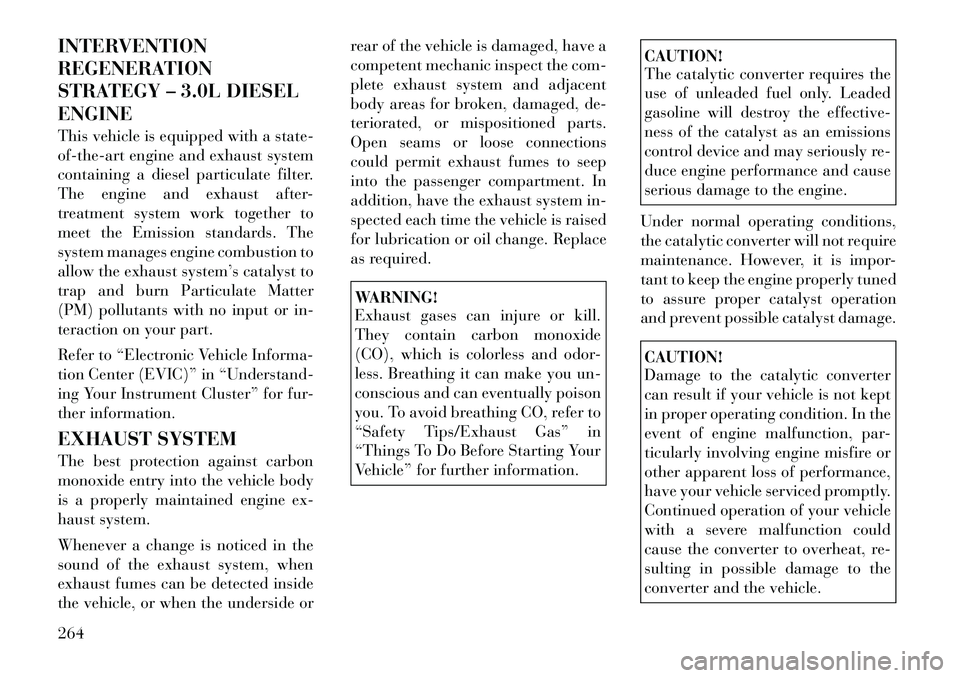
INTERVENTION
REGENERATION
STRATEGY – 3.0L DIESEL
ENGINE
This vehicle is equipped with a state-
of-the-art engine and exhaust system
containing a diesel particulate filter.
The engine and exhaust after-
treatment system work together to
meet the Emission standards. The
system manages engine combustion to
allow the exhaust system’s catalyst to
trap and burn Particulate Matter
(PM) pollutants with no input or in-
teraction on your part.
Refer to “Electronic Vehicle Informa-
tion Center (EVIC)” in “Understand-
ing Your Instrument Cluster” for fur-
ther information.
EXHAUST SYSTEM
The best protection against carbon
monoxide entry into the vehicle body
is a properly maintained engine ex-
haust system.
Whenever a change is noticed in the
sound of the exhaust system, when
exhaust fumes can be detected inside
the vehicle, or when the underside orrear of the vehicle is damaged, have a
competent mechanic inspect the com-
plete exhaust system and adjacent
body areas for broken, damaged, de-
teriorated, or mispositioned parts.
Open seams or loose connections
could permit exhaust fumes to seep
into the passenger compartment. In
addition, have the exhaust system in-
spected each time the vehicle is raised
for lubrication or oil change. Replace
as required.
WARNING!
Exhaust gases can injure or kill.
They contain carbon monoxide
(CO), which is colorless and odor-
less. Breathing it can make you un-
conscious and can eventually poison
you. To avoid breathing CO, refer to
“Safety Tips/Exhaust Gas” in
“Things To Do Before Starting Your
Vehicle” for further information.
CAUTION!
The catalytic converter requires the
use of unleaded fuel only. Leaded
gasoline will destroy the effective-
ness of the catalyst as an emissions
control device and may seriously re-
duce engine performance and cause
serious damage to the engine.
Under normal operating conditions,
the catalytic converter will not require
maintenance. However, it is impor-
tant to keep the engine properly tuned
to assure proper catalyst operation
and prevent possible catalyst damage.CAUTION!
Damage to the catalytic converter
can result if your vehicle is not kept
in proper operating condition. In the
event of engine malfunction, par-
ticularly involving engine misfire or
other apparent loss of performance,
have your vehicle serviced promptly.
Continued operation of your vehicle
with a severe malfunction could
cause the converter to overheat, re-
sulting in possible damage to the
converter and the vehicle.
264